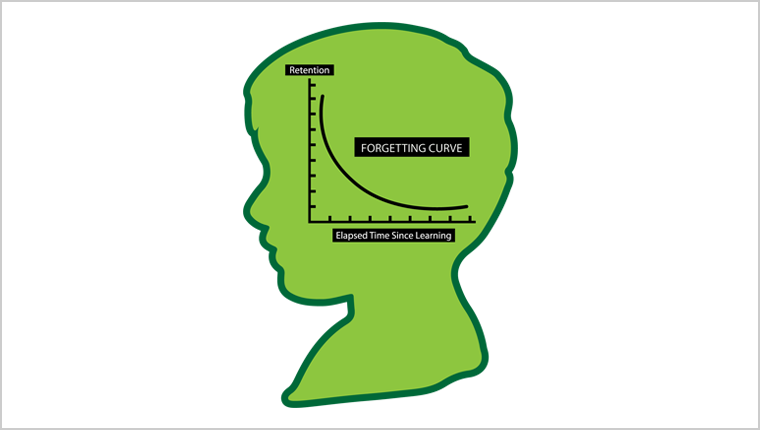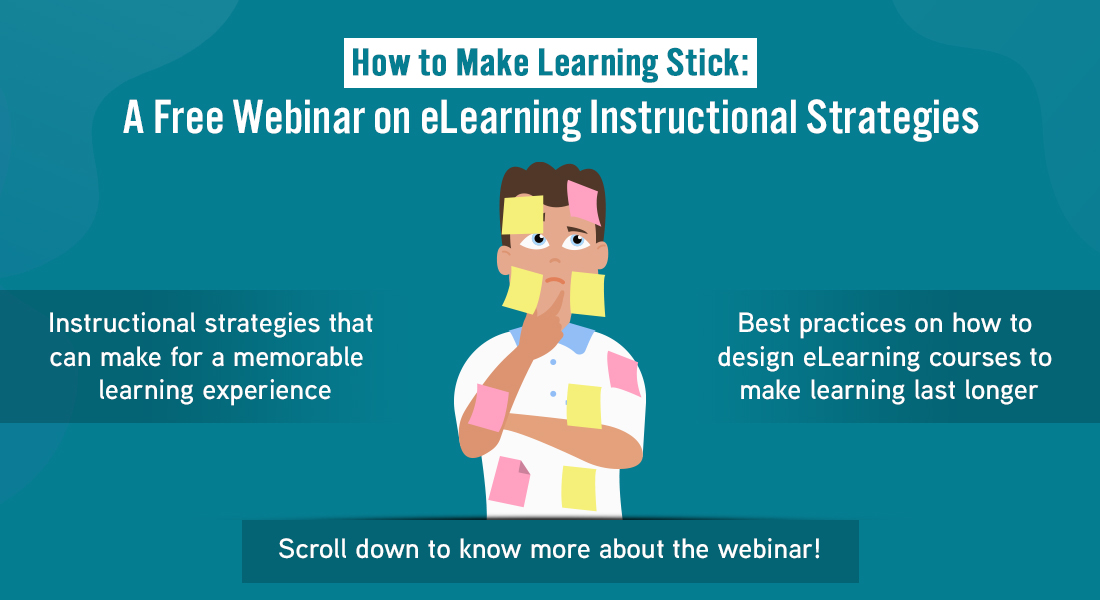6 Ways to Beat the Forgetting Curve in Online Training

Let me start off by asking a simple question. How often have you undergone an online training program and remembered every bit of information right after that? Perhaps never, right? That’s entirely down to Hermann Ebbinghaus’ Forgetting Curve.
Ebbinghaus’ forgetting curve brings to light how quickly humans forget newly acquired information if there’s no attempt to retain it. Being a training manager responsible for ensuring effective training in your organization, the forgetting curve certainly presents an obvious challenge. Moreover, investing training dollars and time in course creation for training is ineffective if your learners are unable to absorb what they learn and apply the same to perform their jobs efficiently.
So, before we jump onto how to overcome the forgetting curve in online learning, let’s get to know what exactly it is.
Defining Hermann Ebbinghaus’ Forgetting Curve
The forgetting curve is a carefully drafted mathematical calculation by Ebbinghaus in the year 1855. The theory suggests that most learners lose newly acquired information within days, weeks, and months of training – unless the information is consciously repeated and presented in meaningful and different ways.

Image Source: Psychestudy
According to studies, learners might forget 40% of newly acquired information in 20 minutes, and 77% in the next six days. The rate at which a learner forgets depends on a lot of factors including memory strength, how meaningful the learner finds the information, and stress levels. So, does this mean your money and efforts go down the drain in just few days? Well, not really.
Ebbinghaus also found out how the rate of forgetting can be effectively curbed if your learners are given opportunities to revise the learning periodically. To put it simply, if learning is reinforced through well-structured and spaced revisions, combatting the forgetting curve is no herculean task. To answer the elephant in the room, how should the reinforcement sessions be organized? How engaging and different can you make it for learners?
6 Ways to Beat the Forgetting Curve in Online Training Program
Planned Reinforcement
One of the effective ways of reinforcing information in online training is to plan for periodic training initiatives. These can become a crucial part of your long-term training and development. Let’s see the different methods you can use in planned reinforcement.
1. Microlearning Modules
While it is important for your employees to undergo formal training, be it classroom sessions or eLearning curriculums, your organization can utilize microlearning modules to reinforce the important information learned in these training sessions.
Microlearning modules refer to the delivery of learning content which can be standalone – each about 10 minutes, enabling learners cover one learning objective comprehensively. But, how do microlearning modules enhance effective retention of knowledge?
By Reducing Cognitive Load: Cognitive load implies the intellectual effort required by a learner to comprehend information. The greater the cognitive load, more the chances of learners forgetting information quickly. Hence, content broken into bite-sized nuggets enable learners to digest the information with ease. The human brain is more suited to retain morsels of information than heaps of it.
By Maximizing Retention: Retention levels can be improved when bite-sized learning modules are spaced over time and repeated at right intervals. The intervals by which repetitions are spaced can make a huge difference in how well a learner learns and retains. Microlearning nuggets in online training should be delivered within two days, after 15 days, and 60 days of training to maximize knowledge retention.
Some of the microlearning formats in online training that can be used for effective reinforcement of learning are eBooks, PDFs, game-based nuggets, videos, and infographics.
2. Scenarios, Simulations, and Gamification
The human brain is quite selective when it comes to storing information permanently. This will naturally accelerate the rate of forgetting. One way to combat this is to make the learning content as relevant and relatable to learners as possible. When learners are aware of why they need the information presented, learning becomes more meaningful. How do you make learning relevant in online training program?
Scenarios: You can make eLearning courses relevant by relating them to your learner’s job profile and role, by including real-life examples and scenarios they are most likely to experience on a day-to-day basis. Making it relevant to their jobs also fosters higher engagement by allowing learners to see the consequences of a particular course of action.
Simulations: Simulation in eLearning allows your learners to avail hands-on training and practice their skills without having to worry about real-life repercussions. Simply put, eLearning simulations use simulated environments to prepare your learners for real-life challenges. For instance, simulations for software training or in the aviation industry. Close resemblance to real-life makes it relevant and relatable for learners to retain the information for longer timeframe.
Gamification: Another way to tackle the forgetting curve is to negate the scope of passive learning by actively engaging your learners. And gamification in eLearning just offers you that. Gamification applies the game-mechanics of badges, levels, points, and leaderboards to eLearning. Motivation comes in the form of winning and obtaining these rewards, which drives better learning and retention – beating the forgetting curve in online training.
3. Online Assessments and Quizzes
After your learners participate in the formal training sessions – classroom or eLearning – evaluate their knowledge through formal online assessments. In order to fair the assessments, your learners will try to retrieve the acquired knowledge from their memories.
This can be facilitated by answering Multiple Choice Questions (MCQs) or solving challenges by playing game-based nuggets. You can even use game-based learning assessments that allow learners to travel through an individual learning path overcoming challenges and achieving the learning objectives.
Providing diagnostic feedback is another effective way to reinforce the correct knowledge. Feedback should clearly state why a choice is right or wrong, without leaving any room for speculation. Ensure your employees have the opportunities to evaluate their knowledge periodically.
On-demand Learning
Another method to challenge the forgetting curve in online training is to have learning resources that can be accessed by learners when they need. In a nutshell, offer them learning right when they need it. Also known as performance support, learning at the time of application results in better and longer retention. Performance support tools are learning aids designed to help learners perform better. These on-demand assets can be hosted on your organization’s LMS or learning portal so that learners have the flexibility to access them based on their requirement. Here are some of the popular digital learning formats that you can use as performance support.
4. How-to Videos
To put it straight, much of what we learn is by watching others accomplish similar tasks. For instance, try remembering how many times you referred to a How-to-Video in YouTube for something as basic as opening a Facebook account or changing a car tire. Pretty evidently, how-to-videos are the perfect to help understand the steps that goes into accomplishing complex procedures or tasks.
Similarly, how-to-videos can also be used as performance support in online training. Your employees can avail them anywhere, on their preferred devices. It can be about steps to follow to repair a machine, troubleshooting tips, or the steps to use a new software.
5. Interactive and Motion Infographics
Infographics are highly visual and information-driven storytelling formats that provides quick takeaways, aiding faster transmission of information and enhancing comprehension. Infographics are eye-catching and easy to scan due to chunked content and visual representation of content, which assists the learning process.
If you are in a fix about the effectiveness of infographics, here’s some news for you. Research suggests visual information is more memorable and around 90% of the information transmitted to your brain is visual in nature. Hence, when the same learning content is presented both in the form of text and visuals, the brain is more likely to retain the information communicated through visuals. Then why give infographics a miss?
And, if you thought conventional infographics are passive and boring, you can go the extra mile by incorporating interactivities and adding motion to static infographics. Interactivities allows for adding more information on click, without overwhelming the learner. Motion infographics such as motion videos and GIFs are becoming popular for their visual richness and short duration.
6. Social Learning Elements
Modern-day learning technologies allow the incorporation of social learning elements that encourage learners to ask questions freely, reply to those who are seeking answers, share what they know, and collaborate to find the right solutions. The consistent interaction between colleagues and exchange of information results in beating the forgetting curve in online training. How do you leverage social learning in eLearning?
Apart from using social media platforms to keep your learners updated with the latest information, you can use discussion forums (hosted on your LMS) and even user-generated content such as videos and podcasts. Discussion forums in eLearning allow learners to seek instant answers to their queries from their peers and learn from their experiences, be it about best practices or troubleshooting tips.
User-generated content in online learning such as video and podcasts come as a handy option for effective just-in time learning. Learners relate better to the experiences of peers who have accomplished the same.
Needless to say, technology plays an integral role in each of these methods to beat the forgetting curve. While your organization might deliver the initial training in the classroom or online, you can use these six methods to assess, train, and reinforce with the help of technology-based interventions.
Now that you know these six exciting ways to beat the forgetting curve in online training, you might be interested in going an extra mile by knowing the different methods to engage learners in online training. Here’s a free eBook on “Instructional Design Strategies to Design Engaging eLearning Courses,” you can download to know what it takes to design highly engaging and learner-worthy eLearning courses.





